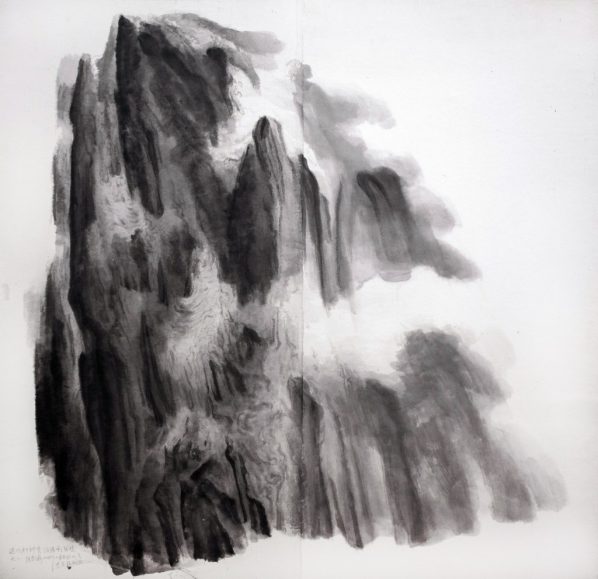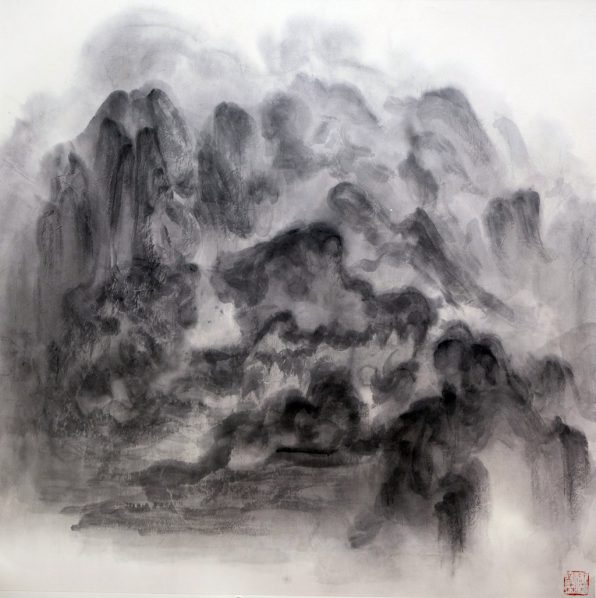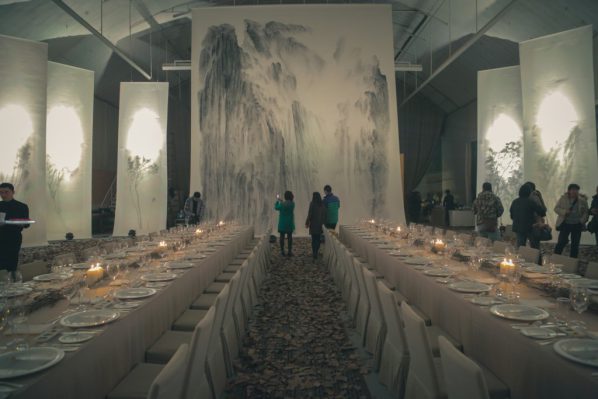
Xu Longsen, Poetic Spirit of Du Fu No. 2, 2010; Ink on paper, 150x147cm; Image Courtesy of the Artist
Xu Longsen’s powerful shanshui (ink-and-brush landscape) paintings are composed from an inimitable blending of traditional and contemporary aesthetics. Through his unique handling of the brush, Xu achieves a fundamental transformation in the nature of brushwork, methodology and artistic conception of ink painting. Xu breaks out of the traditional confines of both studio space and studio practice, and undertakes the challenge of creating monumental works for architectural spaces, opening up unlimited new possibilities for Chinese landscape painting.
Curatorial Statement
From Monumental Landscapes as a Mode of Display to the Literati Gathering as Artistic Uprising
By CHANG Tsong-Zung

Xu Longsen, Cloud Series No. 5, 2015; Ink on paper, 122x122cm; Image Courtesy of the Artist
On the Semi-Private Exhibition
Both European and Chinese cultures have a tradition of ‘semi-private’ exhibition practice: in Europe it is the salon gathering, in China the literati gathering (yaji). Strictly speaking, however, the salon gathering is not a major display practice, but rather only serves as a footnote to museum practice. The significance of this footnote lies with the nature of its constituents, which contrast with those of the museum. As we know, the museum as public space is a phenomenon that originated in the nineteenth century and was directly related to the rise of the new public citizen for whom the creation of and access to a public space was both a right and a duty. In the social contract, the museum does not have the right to refuse entry to any citizen, and in return the public citizen has the duty to comport himself in a manner suited to a member of civic society. Both the art salon and the literati gathering exist outside of this particular relational structure. In these gatherings, participants must be invited or at least be part of the same inner circles. Strangers are not usually welcome nor do they have the right to demand entry.
Monumental ink landscape (shanshui) paintings challenge the conceptual parameters of the modern exhibition hall, and force a consideration of alternative modes of display. In installing his monumental scrolls, Xu Longsen transforms the exhibition hall into a virtual literati garden, in which he replaces the environment of trees, flowers, and rockeries of the natural garden with the environment contained within his scrolls. This act of display within a garden by extension relates to the model of the literati gathering.
Xu Longsen has recently been experimenting with the concept of the semi-private exhibition as a contemporary mode of literati gathering. In a recent event in Beijing, he brought the different art forms that are part of the traditional literati gathering into his environment: not only painting and calligraphy, but also music, dance and chansons. The traditional role of the host in a literati gathering was in this instance replaced by the curator, and it was through the mutual interaction of the artist and the curator that both the audience and the artwork were energized. Within this approach lies the potential for the creation of a new mode of literati gathering for this era.

Among These Mountains and These Trees (Literati Gathering), Xu Longsen's studio in Beijing, 2014; Image Courtesy of the Artist
The Literati Gathering
The literati gathering is essentially an interaction between host and guests. While the guest is not attending as a ‘citizen’, he has an active role to play. The literati guest is here to complete this performance of display together with the host. If he is a connoisseur of calligraphy or painting he will be expected to express his opinion, articulated as a colophon or lines of poetry, sometimes inscribed on the artwork. If he is a connoisseur of performance he is expected to engage intellectually and aesthetically with the performance and exchange his insights. In other words, artworks and performances both need to be brought to life by guests on the occasion. They are fulfilled as artworks within the context of this gathering.
People’s Uprisings as both Celebration and Mobilization
Any event or action that creates a deep impression also creates a response and often will inspire participation. ‘Participatory art’ is an experiment started by a small number of artists in the West; but even when enacted on a grand scale, participatory art cannot compete with the noise and excitement generated by social movements. Yet the powerful global response to the Occupy movements is not necessarily because of their revolutionary nature: rather, their compelling political significance lies in their being participatory actions that generate the hope for a life that challenges taboos and goes beyond regulated boundaries. This is an expectation that cannot be fulfilled by rock concerts or commercially structured festivals. On the other hand, the open spirit of taboo breaking is exactly what makes contemporary art so attractive, and it is precisely here that literati culture has insights to offer. The culture of the literati gathering has always involved a mode of ‘participatory display’ that places an expectation on the audience to play an active role. It is thus up to us to revive the activity of the literati gathering, and to understand it as a kind of ‘artistic uprising’ that offers to the contemporary ‘participatory art’ practice an alternative yet related paradigm with a deep historical resonance. The literati gathering stirs things up and recharges the spirit, because its total effect is that of a kind of personal enlightenment for the participatory audience, one that takes place within their own lives; and at the same time it creates the environment and occasion in which art that is dormant comes fully alive.

Xu Longsen, Cloud Series No. 2, 2015; Ink on paper, 122x122cm; Image Courtesy of the Artist
From the Monumentality of Landscape to the Monumentality of Trees
The influence of the Six Canons of Chinese painting (a treatise written in the sixth century) has endured through the centuries, because of the way it directs artistic pursuit towards the transcendent spirit of nature. The rhythmic spirit of clouds and mists, the flowing arteries of rivers and waterfalls, and the bones and sinews of high mountains and ridges are integral to the language of landscape painting. Xu Longsen’s monumental trees equally and uncannily capture these same qualities of the natural landscape and the nature of landscape painting.
What Volume Tells Us
In traditional culture, people made gardens and rockeries to re-create nature: The legacy of this practice is the literati garden culture. Xu Longsen builds rockeries with ink-and-brush, and plants trees with xuan paper: He is constructing a literati garden with his paint brush, and also a contemporary literati space of display through the arrangement of his paintings within the exhibition hall. Once one steps inside the world of his pictorial display one ceases to yearn for the natural garden and is content to loiter within this space. What he has captured here is the spirit of immanence: Looking up at the towering cliffs of ink is to experience both the weight and gravity of their monumentality and the sensation of soaring into their dizzying heights. Gazing at the mysterious, towering trees is like encountering a spirit in the mist, and an inner smile emerges in the knowing that it is enough to be here, in this space and in this moment, among these mountains and these trees.
Early Spring, the 66th Year of the Republic(Translated by Valerie C. Doran)
About the exhibition
Dates: 24 October - 30 November 2016
Venue: Hanart TZ Gallery
Courtesy of the artist and Hanart TZ Gallery.




























